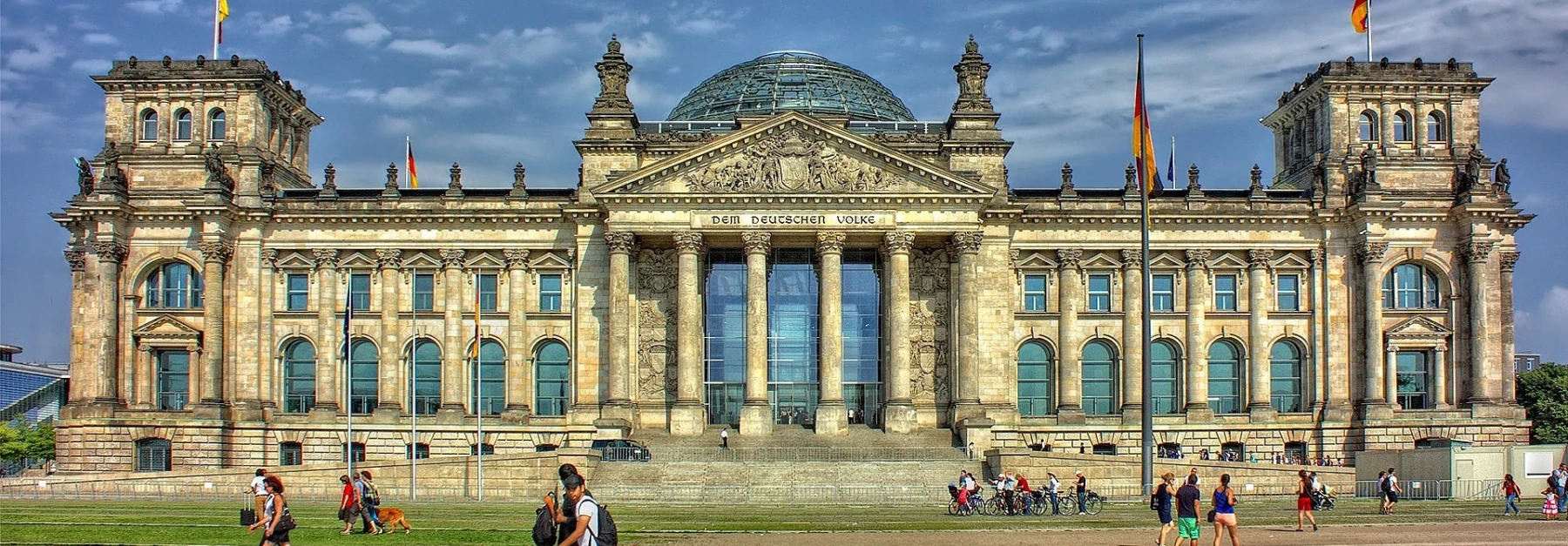The 11 things not to miss in Berlin
Last update : 26/05/2024 15:43Summary
- To visit
-
- 1 - The Brandenburg Gate
- 2 - Berlin Wall Memorial
- 3 - The Reichstag
- 4 - Museum Island (Museumsinsel)
- 5 - Checkpoint Charlie
- 6 - Holocaust Memorial
- 7 - Potsdamer Platz
- 8 - The Television Tower (Fernsehturm)
- 9 - Tiergarten
- 10 - Cruise on the Spree River
- 11 - Berlin nightlife
- Berlin - Where to Stay?
- Berlin - How to get around?
- Berlin - Best period
Berlin is a city that seamlessly blends history and modernity, offering travelers a rich experience filled with culture, history, and diversity. With its iconic landmarks, vibrant neighborhoods, and dynamic atmosphere, Berlin is an unmissable destination for those seeking adventure and discovery.
At the heart of Berlin lies its tumultuous past, marked by events such as World War II and the division of the city during the Cold War. Visitors can explore historical sites like the Berlin Wall, Checkpoint Charlie, and the Holocaust Memorial to understand the impact of these events on the city and the world.
But Berlin is much more than its troubled history. It is also a city of creativity and diversity, boasting a thriving arts scene, contemporary galleries, colorful street art, and a lively nightlife. Neighborhoods like Kreuzberg, Friedrichshain, and Neukölln are teeming with trendy cafes, alternative bars, and underground clubs, attracting party-goers from around the globe.
As you wander the streets of Berlin, you'll also discover a diverse culinary scene, ranging from traditional German dishes to international cuisine, served in innovative restaurants and bustling food markets.
In summary, Berlin is a city that skillfully intertwines its past and present, offering travelers an immersive and captivating experience they won't soon forget. Whether exploring its history, soaking up its culture, or simply enjoying its unique ambiance, Berlin promises an unforgettable adventure for all who visit.
1 - The Brandenburg Gate
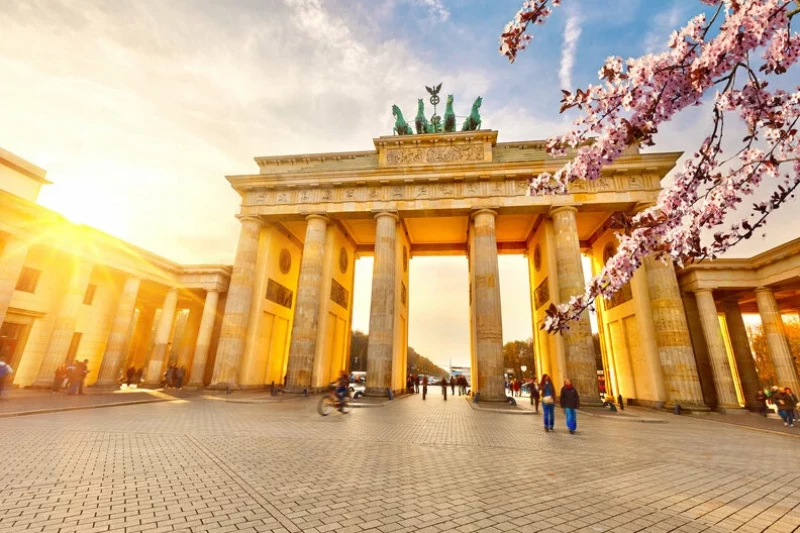
The Brandenburg Gate is an iconic neoclassical monument located in the heart of Berlin, Germany. It stands at the western end of the famous Unter den Linden boulevard and marks the entry to the historic Pariser Platz.
History and Architecture:
- Construction: Built in the late 18th century, from 1788 to 1791, under the direction of Carl Gotthard Langhans.
- Architectural Style: Designed in the neoclassical style, inspired by the Propylaea, the gateway to the Acropolis in Athens.
- Features: The gate consists of twelve Doric columns, six on each side, forming five passageways. The central archway was reserved for royal use only during its early years.
Symbolism and Significance:
- Historical Significance: Throughout its history, the Brandenburg Gate has been a symbol of both division and reunification of Germany.
- Divided Germany: During the Cold War era, the Gate stood in the "no man's land" next to the Berlin Wall, which separated East and West Berlin.
- Reunification: After the fall of the Berlin Wall in 1989 and German reunification in 1990, the Brandenburg Gate became a symbol of peace and unity.
- Cultural Symbol: Today, it is a symbol of German unity and freedom and is one of the most visited landmarks in Berlin.
Cultural References:
- Historical Events: Witnessed many significant historical events, including Napoleon's triumphal procession through the gate in 1806 and the 1987 speech by U.S. President Ronald Reagan urging Soviet leader Mikhail Gorbachev to "tear down this wall."
- Tourism and Festivals: It serves as a backdrop for various events, including New Year's Eve celebrations and cultural festivals.
Restoration and Conservation:
- Restoration: The Gate underwent several renovations, including major restoration efforts after World War II and during the post-reunification period.
- Conservation: It is now meticulously maintained and serves as a symbol of Berlin's resilience and historical heritage.
The Brandenburg Gate remains a potent symbol of Germany's tumultuous history and its enduring quest for unity and freedom.
2 - Berlin Wall Memorial
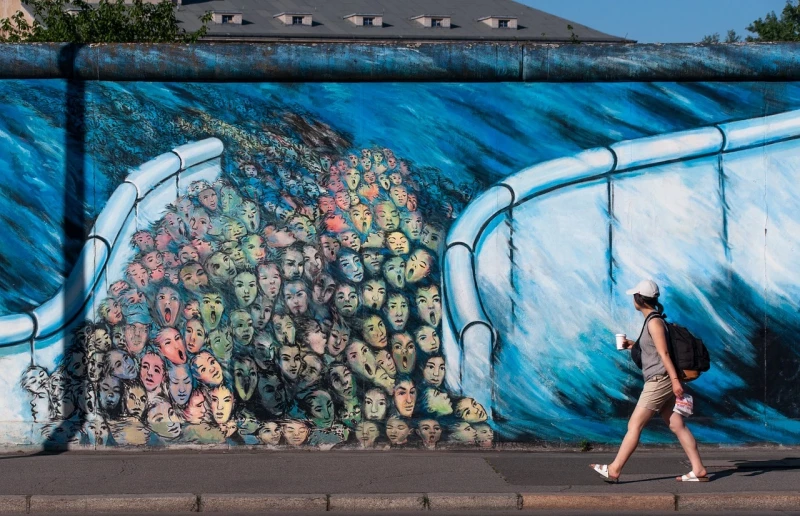
The Berlin Wall Memorial, located in Berlin, is an important commemorative site dedicated to the history and memory of the Berlin Wall that divided the city during the Cold War. Here are some key points about this memorial:
-
Location: The memorial is situated along Bernauer Straße, where a preserved section of the Berlin Wall and border area remains.
-
History: Bernauer Straße was significant during Berlin's division as it cut across the border between the eastern and western sectors of the city. Dramatic events, such as escape attempts and human tragedies related to the Wall, took place here.
-
Components: The memorial includes several elements, such as an original segment of the Wall, a commemorative chapel, outdoor historical exhibitions, and an information center.
-
Information Center: The Berlin Wall Memorial's information center offers detailed exhibitions on the Wall's history, the consequences of its construction and fall, and personal accounts from those who lived through that era.
-
Commemorative Chapel: The chapel honors the victims who lost their lives trying to escape through the Wall, as well as the hardships endured by the divided city's residents.
-
Visiting: The site is open to the public and serves as a poignant place to remember the dramatic events of the Cold War era and the struggle for freedom in Berlin.
The Berlin Wall Memorial not only stands as a historical site but also as a powerful symbol of Berlin's division and reunification, drawing visitors from around the world to reflect on the past and contemplate the lessons of history.
3 - The Reichstag
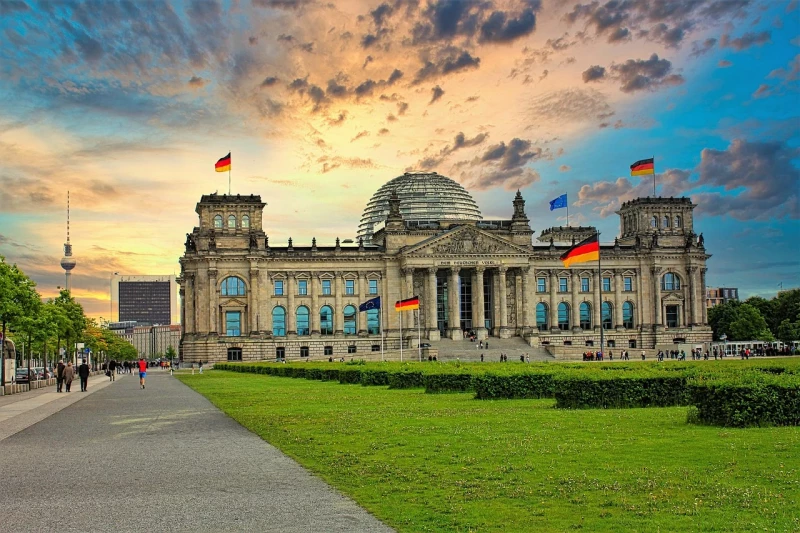
The Reichstag refers to the Parliament of Germany, specifically during different historical periods:
-
Holy Roman Empire: The Reichstag was the assembly of the estates (nobles, clergy, and burghers) of the Holy Roman Empire. It convened irregularly from the Middle Ages until the dissolution of the Empire in 1806.
-
German Empire (1871-1918): After the unification of Germany under Prussian leadership, the Reichstag became the lower house of the German Parliament (Bundestag), representing the people in legislative matters. It played a significant role in the political landscape of Imperial Germany.
-
Weimar Republic (1919-1933): The Reichstag continued as the lower house of the Parliament during the Weimar Republic, a period marked by political instability and economic challenges.
-
Nazi Germany (1933-1945): Following Hitler's rise to power, the Reichstag fire in 1933 was used as a pretext to severely limit civil liberties and consolidate Nazi control. The Reichstag became largely symbolic, with the real power centralized in Hitler's government.
-
Post-World War II: After World War II, the Reichstag building in Berlin remained a symbol of German democracy. It underwent reconstruction and became the meeting place of the Bundestag after German reunification in 1990.
Today, the Reichstag building houses the Bundestag, Germany's federal parliament, and remains an iconic landmark in Berlin, symbolizing German democracy and history.
 Our tips for getting the most out of your experience.
Our tips for getting the most out of your experience.
To visit the Reichstag in Berlin, here are some useful tips:
-
Book Online: It is highly recommended to book your visit in advance through the official Bundestag website. This allows you to choose a specific time slot and avoid long queues.
-
Bring ID: Make sure to have a valid ID with you, as it is required to enter the building.
-
Security Check: Like in any government building, there are strict security measures. Plan for some extra time to go through the security checks at the entrance.
-
Audio Guide: Upon arrival, you can get a free audio guide available in multiple languages, which enhances your visit by providing detailed information about the building's history and architectural features.
-
Panoramic View: Don’t miss the opportunity to climb up to the famous glass dome of the Reichstag, which offers spectacular panoramic views of Berlin. The ascent is included in the visit and provides a unique perspective of the city.
-
Enjoy the Restaurant: The Reichstag also houses a restaurant where you can enjoy German cuisine while overlooking the city. Booking a table in advance might be a good idea to avoid waiting.
-
Accessibility: The Reichstag is accessible for people with reduced mobility. If you have specific needs, feel free to contact the Bundestag in advance to arrange your visit optimally.
By following these tips, you can make the most out of your visit to the Reichstag, exploring its political history and appreciating its modern architectural features.
4 - Museum Island (Museumsinsel)
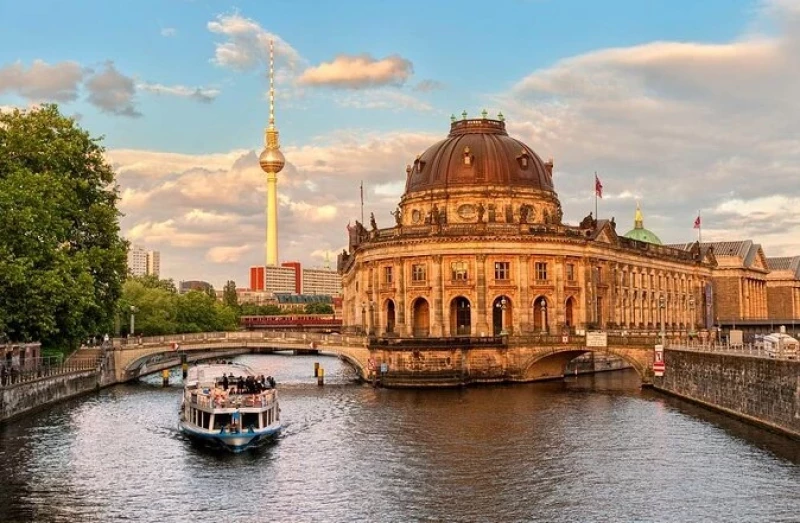
The Museum Island (Museumsinsel in German) is an island complex located in the heart of Berlin, Germany. This remarkable site is home to a cluster of five renowned museums, all situated on the Spree River in the Mitte district of Berlin.
The five main museums on Museum Island are:
-
Altes Museum (Old Museum): Built between 1823 and 1830, it houses a collection of ancient sculptures, including Greek and Roman works.
-
Neues Museum (New Museum): Reopened in 2009 after extensive restoration, it showcases Egyptian antiquities, including the famous bust of Nefertiti.
-
Alte Nationalgalerie (Old National Gallery): This museum specializes in 19th-century art, featuring collections of paintings and sculptures from the Romantic period to Impressionism.
-
Bode Museum: Located at the northern tip of the island, this museum displays collections of Byzantine art, medieval sculptures, and coins.
-
Pergamonmuseum (Pergamon Museum): Known for its extensive collections of ancient artifacts from the Middle East, including the famous Pergamon Altar and the Ishtar Gate.
Museum Island has been a UNESCO World Heritage site since 1999 due to its exceptional concentration of world-class museums. It attracts visitors from around the globe interested in art, archaeology, and ancient history.
 Our tips for getting the most out of your experience.
Our tips for getting the most out of your experience.
Here are some tips for visiting Museum Island (Museumsinsel) in Berlin:
-
Plan your visit in advance: Museum Island is home to five major museums, each with impressive collections. Plan your itinerary in advance based on your interests to make the most of your time there.
-
Buy tickets in advance: To avoid long lines, purchase your tickets online ahead of time if possible. This may also qualify you for discounts or special offers.
-
Consider a combination pass: If you plan to visit multiple museums on Museum Island, consider buying a combination pass that allows you access to several museums at a reduced rate.
-
Visit early morning or late afternoon: To avoid crowds, try visiting the museums early in the morning or later in the afternoon. This will allow you to enjoy the exhibitions in a more relaxed manner.
-
Take your time: Each museum on Museum Island houses unique artistic and historical treasures. Take your time to admire each piece and read the provided information for a rewarding experience.
-
Take advantage of guided tours: Many guided tours are available on Museum Island, offering in-depth information about the collections and history of the museums. It's a great way to learn more and get the most out of your visit.
-
Explore the surroundings: After visiting the museums, explore the surrounding areas of Museum Island. You'll find plenty of cafes, restaurants, and shops to discover in the Mitte district.
By following these tips, you can fully enjoy your visit to Museum Island and explore some of Berlin's most remarkable cultural treasures.
5 - Checkpoint Charlie
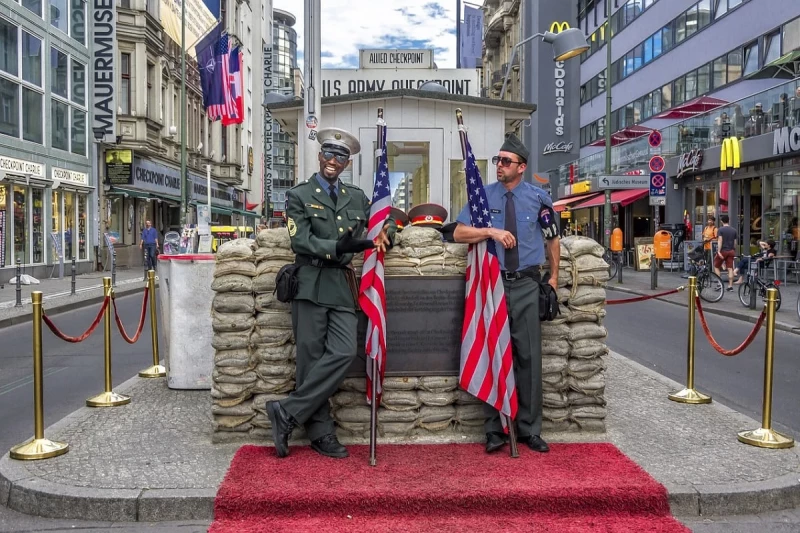
Checkpoint Charlie was the most famous crossing point between East Berlin and West Berlin during the Cold War. It was located at the junction of Friedrichstrasse and Zimmerstrasse and was designated as Checkpoint C by the Western Allies during the Berlin Wall era. This checkpoint gained international significance as a symbol of the division between East and West during the Cold War.
Checkpoint Charlie became a focal point of tensions between the Soviet Union and the Western Allies, especially during the Berlin Crisis of 1961 when the Berlin Wall was erected. It was a site of occasional standoffs and incidents, including the famous confrontation in October 1961 when American and Soviet tanks faced each other at the checkpoint.
After the fall of the Berlin Wall in 1989 and the reunification of Germany in 1990, Checkpoint Charlie lost its former significance. Today, the checkpoint is a major tourist attraction in Berlin, with a replica of the original guard house and sandbags marking its location.
6 - Holocaust Memorial
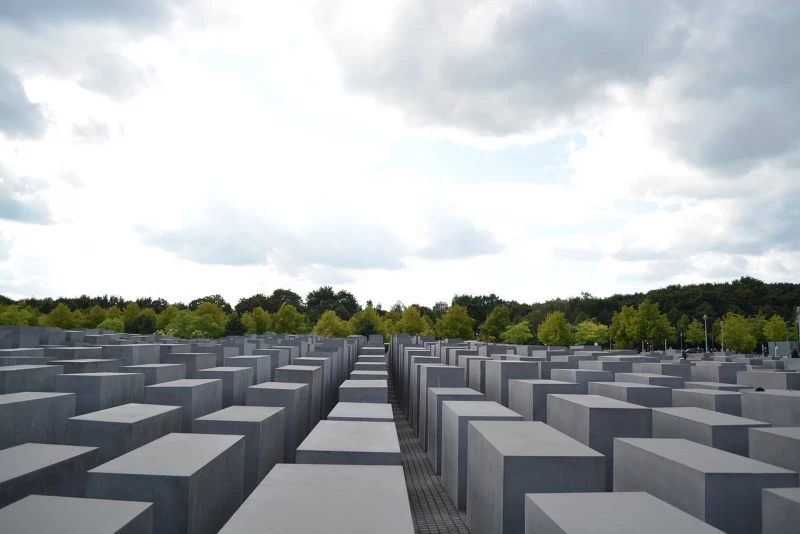
The Holocaust Memorial (or Shoah Memorial) is a place dedicated to the memory of Jewish and non-Jewish victims of the genocide perpetrated by the Nazi regime during World War II. These memorials exist in many countries, each with its own approach and goals, but all aim to remember the horrors of the Holocaust and honor the millions of people who lost their lives.
Some of the most well-known memorials include the Holocaust Memorial in Berlin, Yad Vashem in Jerusalem, and the United States Holocaust Memorial Museum in Washington D.C. Each of these sites offers an educational and emotional experience intended to raise awareness about the history and lessons of the Holocaust, promoting tolerance, understanding, and the prevention of future genocides.
 Our tips for getting the most out of your experience.
Our tips for getting the most out of your experience.
Visiting a Holocaust Memorial can be a deeply emotional and profound experience. Here are some tips to make your visit meaningful and respectful:
-
Emotional Preparation: The Holocaust is a serious and somber topic. Take time to emotionally prepare yourself for the intense experience you may encounter.
-
Learn Before You Go: Educate yourself about the history of the Holocaust before your visit. Understanding the historical context will help you better appreciate what you see and feel.
-
Respect the Space: Remember that a Holocaust Memorial is a place of remembrance. Be respectful to other visitors and avoid inappropriate behavior such as taking selfies or being noisy.
-
Take Your Time: Don’t rush. Take the time to read the information presented, view the exhibits, and reflect on what you're experiencing.
-
Listen to Survivor Stories: Many Holocaust Memorials offer survivor testimonies. Listen attentively to these firsthand accounts to gain a deeper understanding of the individual experiences behind the statistics.
-
Reflect After Your Visit: After your visit, take time to reflect on what you saw and felt. The Holocaust raises complex questions about humanity and society, and personal reflection can enhance your understanding.
-
Support Education and Memory: Consider supporting Holocaust education and memorial preservation through donations or volunteer work after your visit.
By following these tips, you can enhance your experience at a Holocaust Memorial while respecting the historical and emotional significance of the site.
7 - Potsdamer Platz
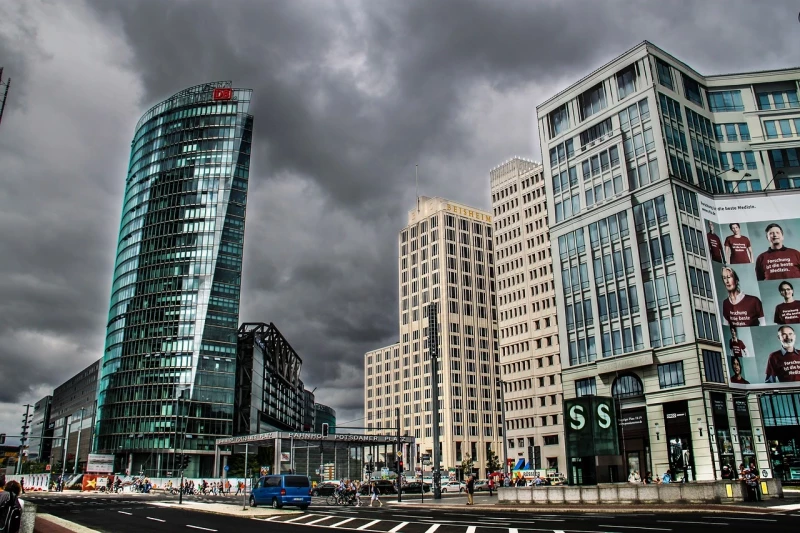
Potsdamer Platz is a significant public square and traffic intersection in the center of Berlin, Germany. Historically, it was one of the busiest squares in Europe prior to World War II, but it was heavily damaged during the war and later divided by the Berlin Wall, which ran through its eastern part.
After the reunification of Germany, Potsdamer Platz underwent extensive redevelopment and is now a bustling modern area with skyscrapers, offices, entertainment venues, and shopping centers. It serves as a symbol of Berlin's renewal and modernization following the Cold War era.
8 - The Television Tower (Fernsehturm)
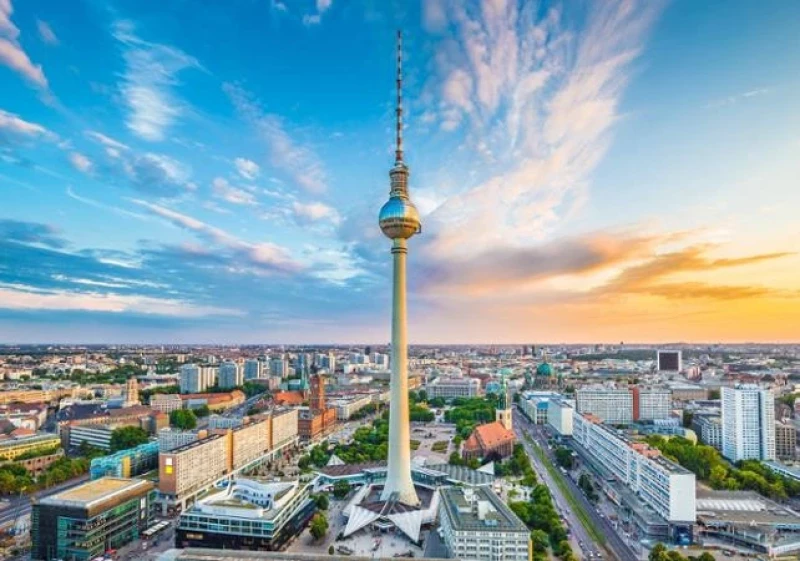
The Fernsehturm, known in English as the Television Tower, is a prominent landmark in Berlin, Germany. Standing at 368 meters (1,207 feet) tall, it is the tallest structure in Germany and one of the tallest in Europe. Here are key details about the Fernsehturm:
-
Construction and Purpose: Built between 1965 and 1969 by the government of the German Democratic Republic (East Germany), the Fernsehturm was constructed as both a telecommunications tower and a symbol of East German technological advancement.
-
Design: The tower was designed by architects Fritz Dieter, Günter Franke, and Werner Ahrendt. Its distinctive feature is its spherical top, which houses a revolving restaurant and an observation deck.
-
Location: Situated in Berlin's central Mitte district near Alexanderplatz, the Fernsehturm is a significant part of the city's skyline and urban landscape.
-
Height and Structure: Its height and the spherical structure make it easily recognizable from various parts of Berlin. It was strategically placed to provide television broadcasting coverage over a wide area.
-
Tourist Attraction: Today, the Fernsehturm is not only an important telecommunications hub but also a popular tourist destination. Visitors can take an elevator to the observation deck, located at a height of over 200 meters, to enjoy breathtaking views of Berlin.
-
Symbolism: During the Cold War era, the Fernsehturm symbolized the technological achievements and political landscape of East Germany, serving as a symbol of its aspirations and capabilities.
In summary, the Fernsehturm is not just a television tower but a cultural icon of Berlin, offering visitors a chance to appreciate the city's history and modernity from a unique vantage point.
9 - Tiergarten
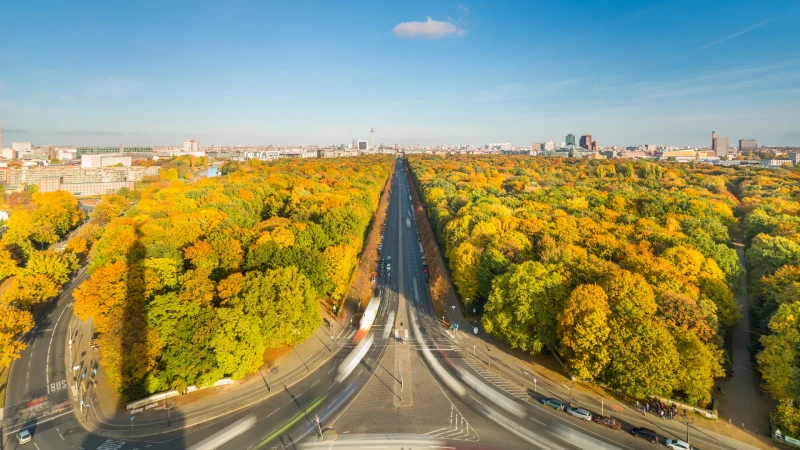
Le Tiergarten est un grand parc urbain situé au centre de Berlin, en Allemagne. Il couvre une superficie d'environ 210 hectares (520 acres) et est l'un des parcs les plus célèbres et populaires de la ville. Le nom "Tiergarten" se traduit littéralement par "jardin des animaux" en anglais, ce qui reflète ses origines en tant que réserve de chasse pour les rois prussiens. Aujourd'hui, il sert d'espace de loisirs pour les Berlinois et les visiteurs, avec des jardins paysagers, des sentiers de promenade, des lacs et divers monuments et statues.
Pendant la Guerre froide, le Tiergarten était situé juste à côté du mur de Berlin, en faisant un symbole poignant de la division entre l'Est et l'Ouest de la ville. Depuis la réunification de l'Allemagne, le parc a été restauré et réaménagé de manière extensive, devenant à nouveau un espace public dynamique.
Le Tiergarten abrite également plusieurs monuments importants, notamment la Colonne de la Victoire de Berlin (Siegessäule), le bâtiment du Reichstag (siège du parlement allemand) et la Porte de Brandebourg, tous des symboles emblématiques de l'histoire et de la culture de Berlin.
Les visiteurs du Tiergarten peuvent profiter de promenades paisibles, de pique-niques, de vélo et même de balades en bateau sur ses lacs. Il reste une partie essentielle du paysage de Berlin, offrant un mélange de beauté naturelle, d'histoire et de tranquillité urbaine au cœur de la ville animée.
10 - Cruise on the Spree River
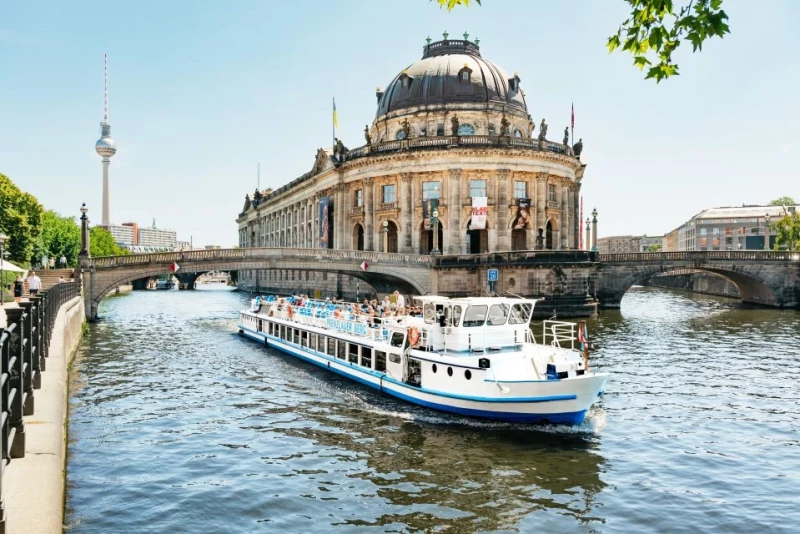
A cruise on the River Spree in Berlin is a fantastic way to explore the city from a different perspective. Here are some key points you might mention if you're planning this activity:
-
Starting and stopping points: Spree river cruises typically depart from various points along the river, including near the Brandenburg Gate and Museum Island.
-
Famous landmarks: You'll pass by several iconic sites such as the Reichstag (parliament building), the TV Tower (Fernsehturm), and the German Historical Museum.
-
Modern architecture: The river offers a beautiful view of Berlin's newer architectural developments, like the Philharmonie and the government quarter.
-
Relaxing atmosphere: It's a peaceful and enjoyable experience, perfect for unwinding after a day of sightseeing.
-
Cruise options: You can choose from guided tours with commentary in multiple languages, romantic dinner cruises in the evening, or shorter cruises for a quick view of the main landmarks.
-
Duration and pricing: Prices vary depending on the duration and type of cruise you choose, but it's generally an affordable activity for visitors.
If you have any more questions about specific details or need further recommendations, feel free to ask!
11 - Berlin nightlife
Berlin's nightlife is legendary and diverse, drawing visitors from around the globe for its electric atmosphere and endless possibilities. Here are some key aspects:
-
Iconic clubs: Berlin is famous for its underground clubs like Berghain, Watergate, and KitKatClub, offering unique musical experiences that often last all weekend.
-
Bars and pubs: Neighborhoods like Kreuzberg, Friedrichshain, and Neukölln are brimming with trendy cocktail bars, historic pubs, and microbreweries.
-
Festivals and events: Berlin regularly hosts electronic music festivals like the renowned Love Parade (before its hiatus) and the Carnival of Cultures, along with artistic and cultural events year-round.
-
Alternative culture: Berlin's alternative scene thrives with art spaces, galleries, theaters, and street performances, particularly concentrated in Mitte and Prenzlauer Berg.
-
Speakeasies and hidden bars: In addition to well-known spots, Berlin boasts numerous hidden bars where you can discover inventive cocktails and intimate atmospheres.
-
Diversity and inclusivity: Berlin's nightlife is known for its openness and welcoming attitude towards people from all backgrounds, making it a sought-after destination for those seeking freedom of expression and diversity.
In summary, Berlin's nightlife offers a unique blend of history, music, art, and a constant party atmosphere, attracting an international crowd of revelers, artists, and explorers.
 Our tips for getting the most out of your experience.
Our tips for getting the most out of your experience.
To fully enjoy Berlin's vibrant nightlife, here are some practical tips:
-
Plan your evening: Berlin is vast with diverse neighborhoods offering different vibes. Research ahead to find clubs, bars, or events that suit your musical tastes and style.
-
Themed nights and special events: Check websites and social media for themed nights, special events, or festivals happening during your stay.
-
Opening hours: Clubs in Berlin often have late-night or even non-stop weekend hours. Make sure to check opening times to avoid finding yourself in front of a closed door.
-
Dress code: While Berlin is generally casual, some clubs may have specific dress codes or restrictions. Check venue guidelines beforehand.
-
Transportation: Berlin has a well-developed public transport system, but some places may be more accessible by taxi or rideshare at night. Know how you'll get home after a night out.
-
Safety: Like any major city, remain aware of your surroundings and belongings. Avoid risky situations and be mindful of fellow partygoers.
-
Explore neighborhoods: Don’t limit yourself to well-known spots. Explore neighborhoods like Kreuzberg, Friedrichshain, Neukölln, Mitte, and Prenzlauer Berg for lesser-known but equally lively bars and clubs.
-
Meet locals: Berlin's nightlife is also a great opportunity to meet Berliners. Be open to interactions and new experiences.
By following these tips, you'll have an unforgettable nightlife experience in Berlin, exploring its cultural diversity and vibrant artistic scene.
Berlin - Where to Stay?
Berlin is a diverse city with many neighborhoods, each with its own character and attractions. Here are some of the most popular areas to stay and visit in Berlin:
Mitte:
- Description: The historical heart of Berlin, Mitte houses many major tourist sites such as the Brandenburg Gate, Museum Island, the TV Tower (Fernsehturm), and Unter den Linden boulevard.
- Accommodation: A wide range of hotels, including luxury and boutique options.
- Atmosphere: Very touristy, with plenty of restaurants, bars, and shops.
Kreuzberg:
- Description: Known for its vibrant arts and alternative scene, Kreuzberg is a dynamic neighborhood with a strong multicultural influence.
- Accommodation: Numerous hostels, boutique hotels, and Airbnb apartments.
- Atmosphere: Young, bohemian, with many bars, clubs, and art galleries.
Friedrichshain:
- Description: Located in East Berlin, Friedrichshain is famous for its lively atmosphere and nightlife. It is home to the East Side Gallery, a long stretch of the Berlin Wall decorated by artists.
- Accommodation: Hostels, hotels, and apartments.
- Atmosphere: Energetic and alternative, with a very active nightlife and many trendy cafes.
Prenzlauer Berg:
- Description: This neighborhood is known for its cobblestone streets, historic buildings, and bohemian, family-friendly atmosphere. There are many cafes, organic restaurants, and vintage shops.
- Accommodation: Boutique hotels, apartments, and B&Bs.
- Atmosphere: Bohemian and family-friendly, with many young families and creative professionals.
Charlottenburg:
- Description: A more upscale area in West Berlin, known for its wide boulevards, luxury shops, and theaters. Charlottenburg Palace is a major attraction.
- Accommodation: Luxury and mid-range hotels.
- Atmosphere: Elegant and quiet, with a more traditional vibe.
Schöneberg:
- Description: A diverse neighborhood with a rich history, Schöneberg is also known for its LGBT scene.
- Accommodation: Hotels, apartments, and hostels.
- Atmosphere: Cosmopolitan and inclusive, with a lively nightlife and many restaurants and bars.
Neukölln:
- Description: An up-and-coming neighborhood, Neukölln is increasingly attracting young people and artists. It's known for its hip bars, cafes, and markets.
- Accommodation: Hostels, apartments, and a few hotels.
- Atmosphere: Eclectic and trendy, with a young and creative vibe.
These neighborhoods offer a variety of experiences and atmospheres, whether you're interested in history, art, nightlife, or simply exploring local life in Berlin. Choosing the right area depends on your personal interests and what you want to experience during your stay in Berlin.
Berlin - How to get around?
To get around and explore Berlin, you have several efficient and well-developed transportation options:
-
Subway (U-Bahn) and Suburban Trains (S-Bahn): The subway (U-Bahn) and suburban trains (S-Bahn) network covers most parts of the city and is highly efficient. U-Bahn lines are identified by numbers (U1, U2, etc.) and S-Bahn lines by letters (S1, S2, etc.). They generally operate from around 4:30 AM to 1:30 AM.
-
Tram (Straßenbahn): Trams are a convenient way to travel, especially in areas where the subway doesn't reach. There are several tram lines throughout Berlin.
-
Bus: The bus network is extensive and complements the subway and tram system, providing connections to neighborhoods and areas less served by other modes of transport.
-
Bicycles: Berlin is a bike-friendly city with many bike lanes and a bike-sharing system (such as Deutsche Bahn's Call a Bike or Lime and Voi bikes). It's a great way to get around while exploring the city at your own pace.
-
Car: While Berlin has a good road network, traffic can be dense and parking can be challenging to find. Using public transport or bicycles is often more convenient for getting around the city.
-
Taxi and Ride-Sharing Services: Taxis and ride-sharing services like Uber are widely available in Berlin. They can be useful for quicker trips or reaching places less accessible by public transport.
To use public transport in Berlin, you can purchase single tickets or opt for daily or weekly passes, which often offer discounts for groups. Make sure to validate your ticket before entering the subway or tram to avoid a fine. Berlin is also a pleasant city to explore on foot, so don't hesitate to walk around certain parts to fully experience its unique charm.
Berlin - Best period
Berlin can be visited year-round depending on your personal preferences and the activities you want to experience:
-
Spring (March to May): Spring in Berlin is pleasant with mild temperatures, ideal for enjoying parks and outdoor terraces. It's a great time to visit museums and historical sites without the summer crowds.
-
Summer (June to August): Summer in Berlin is hot and vibrant. It's the season for festivals, outdoor events, and long sunny days. Parks, lakes, and outdoor cafes are very popular. However, expect more crowds at tourist attractions.
-
Autumn (September to November): Autumn offers mild temperatures and beautiful fall colors in the city parks. It's a good time to explore street markets and attend cultural events.
-
Winter (December to February): Winter in Berlin can be cold with temperatures often below freezing, but it's also a festive time with Christmas markets and decorations. Museums and art galleries provide indoor refuge from the cold.
In summary, each season in Berlin has its own charm and activities to offer: outdoor festivals and events in summer, colorful parks in autumn, Christmas markets in winter, or quieter museum visits in spring. Be sure to check local events and attraction hours when planning your visit.
